
A Cave of Candles / by Dorothy V. Corson

Chapter 13a
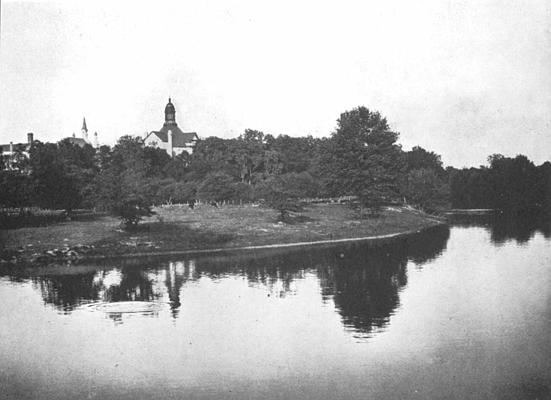
One Lucky Break Leads to Others
Energized by this new found information, I decided to shorten my planned week off before the holiday and squeeze in a couple more days of searching. I didn't want to let the trail get too cold while the University Archives was closed for the long Christmas break. Those two days produced all I needed to complete my research on the original St. Mary's Grotto.
The following excerpts from the pages of the Scholastic emphasize the fact that the St. Mary's Grotto was definitely Mother Angela's own inspiration. I found this additional information I missed the first time around. It was written for the Baltimore Catholic Mirror, and reprinted in the Scholastic, by the same woman, Mary Regina Jamison, who visited both Notre Dame and St. Mary's on the day of Father Sorin's dedication of his Grotto. It was she who proclaimed the St. Mary's Grotto as coming "nearer the original than any she has seen either in this country or in Europe."
In 1878, under the title of "An Indiana Academy," and following a lovely description of St. Mary's, the writer speaks of its Grotto:
To sanctify all these natural enjoyments of the campus, there is a spiritual atmosphere pervading the whole place that would rejoice the heart of Father Faber: plenty of beautiful oratories in the house and about the play-grounds, a Grotto of Lourdes, and a facsimile of the Holy House of Loretto. Although an indoor arrangement, the grotto is the first correct reproduction of the real Grotto of Lourdes that I have seen in America. Many churches and religious houses have so-called grottoes, but they are only handsome oratories, entirely unlike the rocky spot where our Immaculate Mother appeared to Bernadette. The inaccurate pictures sent to this country must bear the blame of these mistakes; it is difficult to understand why such pictures should be scattered, broadcast through the world, when correct copies of the place could as easily be had. Defects in pictures of imaginary subjects may be excused, but it is unpardonable to send forth unfaithful representations of a sacred place so accessible as the Holy Grotto of Lourdes. At an early date the Mother Superior intends having a grotto in the Academy grounds at a spot on the river bank [in the glen] closely resembling the natural situation of the Grotto of Lourdes. No doubt many devout persons who find it impossible to cross the ocean will then gladly make a pilgrimage to St. Mary's Grotto.(140)
Could viewing Sorin's new octagonal shrine-like Grotto dedicated on the same day she saw both Grottoes have triggered Miss Jamieson's above mention of "inaccurate oratories?" Obviously, the river bank in the glen had been the place Mother Angela had planned to build another, outdoor, Grotto. With the area being along the river, so much like the Grotto of Lourdes setting, it was ideally suited for it. This Grotto was never built by Mother Angela. Could Father Sorin's early Grotto dedicated the same year this letter was written usurped her plans?
I recalled another incident mentioned in St. Mary's history books of how Mother Angela had given up the Our Lady of Sacred Heart Church name chosen for their future church, and the funds she had already collected for it, to Father Sorin to build his new church at Notre Dame. This entailed delaying their own church plans for many years.
I found a mention of this incident in a pamphlet entitled "Sisters of the Holy Cross at Notre Dame." The writer, Father Arthur Hope, was allowed by Sister Mansuetus, to read the Sisters Chronicles which were kept in a tremendous volume labeled "Record." From it, he took items of interest to reproduce in the pamphlet. Among them was this interesting excerpt:
Sometime in 1866 or 1867, permission was given Mother Angela by
Father Sorin to carry out a project very dear to her heart: namely the
erection of a church at St. Mary's. She went to work with a will and
with the aid of Sister Mildred, hundreds of letters were sent out to
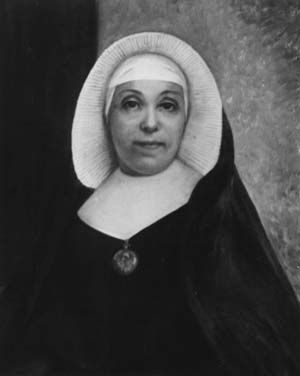 the wealthy patrons of St. Mary's soliciting donations for this object,
and promising many spiritual benefits and a share in a Perpetual Mass
to the benefactors.
the wealthy patrons of St. Mary's soliciting donations for this object,
and promising many spiritual benefits and a share in a Perpetual Mass
to the benefactors.
Meanwhile, Very Rev. Father Sorin went to Europe [1869], and Father Granger, hearing of Mother Angela's success in making collections, wrote to Father General [Sorin] relating to the subject -- suggesting to him that the church should be erected at Notre Dame, that Mother Angela could not fulfill the promise of the Perpetual Mass, etc. Mother Angela yielded to Very Rev. Father General's request, and gave Father Granger $3,452.00 which she had collected.
This was a great blow to many of the Sisters who had set their hearts on having a church at St. Mary's. In this, as in other things, Father General's strong will dominated, and St. Mary's had to be content with having inaugurated the movement.(141)
Joseph M. White's history of the Sacred Heart Parish sheds additional light on Sorin's ongoing interest in making Notre Dame a mecca for religious pilgrimages:
A printed brochure proclaimed to the public the Holy Cross community's aim, decided by its local council the the spring of 1869, to build a new church to surpass their inadequate one. In naming the church, it is interesting to note the new title "Our Lady of the Sacred Heart of Jesus." The old place of worship was definitely dedicated to the Sacred Heart of Jesus at the beginning. But a growing devotion to Our Lady at the university accounts for adopting a different but related name for the proposed church. One manifestation of Marian piety was Sorin's collaboration with Holy Cross Sisters in launching the national magazine Ave Maria in 1865 to promote devotion to Our Lady. Another instance was to place a statue of the Virgin atop the dome of the new college building completed in 1866 [the one destroyed by fire in 1879].(142)
Several months after recording the above information, I was checking Father Granger's papers for something else when by chance I found one of his original letters out of place in his file. A cursory glance at it revealed it to be the letter Father Granger sent to Sorin in France regarding the above matter. It was four pages long, the last page being written on the back of the one before it, and part of it was written in French. The paper was so thin and the ink so faded that only a few places in it were discernible. As I poured over it, I began to pick up more and more of its content, until it became obvious that it was Granger's letter to Sorin concerning Mother Angela, the church name, and the already collected funds toward erecting a new church at St. Mary's.
It was unsigned, undated, and unaddressed so it was unlikely anyone had realized yet its historic content. I pointed it out to Peter, the archivist and offered to transcribe it and translate the French portion of it if he would make me a copy of it. I was fortunate to find that Father Schidel knew French, and in turning it over to him for the French translation, he not only translated the paragraph in French but also deciphered the almost unintelligible English. He not only saved me a lot of time, but he also proved himself to be a master detective. From the approaching death of a Brother mentioned in the contents he discerned the approximate date it was written, in late January, 1869. All I had to do was make a computer copy of it for the archives.
A few lines penned along the border of the last page of the letter were legible and it was these lines that first stirred my interest in it. I pointed them out to Peter as I handed my transcribed computer copy to him. He glanced down at it and recognized it was Father Sorin's handwriting. I hadn't even noticed a difference. Knowing it was Father Sorin's brief reply to Father Granger put the whole letter in context.
It was definitely another archival find, just when I needed it. It also provided the answers to many questions I had been musing over regarding Father Sorin's role in the Lourdes phenomenon on both campuses. This letter, thanks to Father Schidel's keen eye and avid interest in Notre Dame's history, is now legible for future researchers. It has also been dated, and the addresser and addressee discerned. It cannot help but be a rare find for any future historian doing a study of Father Sorin and his early influence on the affairs of the university. This very special letter has been preserved with Father Alexis Granger's papers in the University Archives.
It put a whole new perspective on Father Maguire's assessment of the early background of the Notre Dame Grotto. By the time the letter had been written, in early 1869, the Ave Maria, "launched in collaboration with the Holy Cross Sisters" (first published in 1865), was already a popular national publication. The Association of Our Lady of Sacred Heart , formed soon afterward, seated at St. Mary's and advertised in its pages, was quickly gaining new members.
Undoubtedly, this growing interest in the Our Lady of Sacred Heart Association prompted Mother Angela, in the mid 1860s -- approved by Father Sorin, but unbeknown to Father Granger -- to promote through its membership the funding of a church at St. Mary's bearing the name of the title of the association. It was obviously the success of her undertaking and the consideration of a new church at Notre Dame -- the task of building it turned over to Father Granger by Father Sorin -- that prompted Father Granger to question the ability of the Sisters to carry out the spiritual needs of the fast growing membership of the Our Lady of Sacred Heart Association.
An excerpt from Father Granger's letter reveals his quandary in the paragraph in his letter written in French:
. . . I knew nothing of her plan. I do not blame her but I feel embarrassed . . . . Mother Angela tells me that she has already distributed more than 200 circulars promoting the building of her church. All this, she adds, in her conviction that you would approve. I did not know a thing about this. What is done is done. I beg you not to send any subjects from France until matters are satisfactorily settled.
While in Washington, D.C., Sister Angela learned that Notre Dame was completing its plans for its new campus church and she wrote Sorin, then in Europe, that she hoped his church would be dedicated as the Church of the Sacred Heart of Jesus (the name of its first church) and hers could be dedicated as Our Lady of the Sacred Heart. A reasonable request, since the priests were dedicated to the Sacred Heart of Jesus, the brothers to St. Joseph, and the Sisters to Our Lady of Sorrows. Sister Angela's letter to Sorin in Europe, is obviously the one alluded to in Father Sorin's reply annotated on the side of Father Granger's letter and returned to him:
Here is the letter alluded to in my last. In it, was enclosed one from Mrs. Phelan to your Reverence, a pretty sharp one too! You may judge if I have not in my reply, followed your own sentiment. Right or wrong, St. Mary's in your opinion was too far advanced to secede.(143)
Mary Phelan, the mother of Sister Angela and Father Neal Gillespie, was a great benefactor of Notre Dame and St. Mary's. Careful analysis of Father Granger's letter to Father Sorin, and Sorin's brief annotated reply, seems to suggest that in Father Sorin's reply to Mother Angela, he left it in her hands. And it was she who reconsidered and seceded.
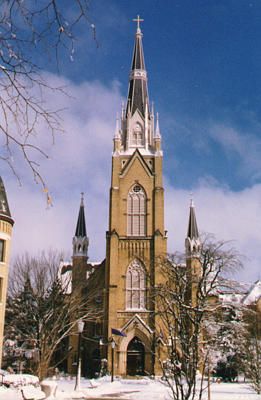
In his A Spire of Faith, Tom Schlereth speaks of Mother Angela's talk with Father Granger upon her return from Washington, D. C. and the (second) letter she wrote to Sorin after that meeting (February 5, 1869) which suggests this may have been the case:
I have since come to the conclusion that it is your decided wish to call the church at Notre Dame, Our Lady of Sacred Heart. Therefore dear Father be assured that I cheerfully withdraw our petition and will work for the Church at Notre Dame if you think it best.
A month later (March 22, 1869) Angela wrote Granger, enclosing a draft for $1400, in order that 'a great monument to our Blessed Mother can be erected in the United States.' 'I now feel satisfied,' she wrote, 'this should be at Notre Dame in preference to Saint Mary's'. She concluded: 'After a while I am sure (if Providence does not grant other means) that you all at Notre Dame will help to put up a chapel in which we will be able to have Mass the year round.'(144)
And so, history records that Mother Angela did secede. When Sorin returned from Europe she sent Father Granger the funds she had already collected to date $3,452. Seventeen years later, in 1886, a year before Mother Angela died at the age of 63, she saw the completion of St. Mary's Community church dedicated to Our Lady of Loretto. Her mother, Mary Phelan, died 8 months later.
The Our Lady of Sacred Heart Association was also taken over by Father Granger, transferred to Notre Dame, at the same time. Favors granted by Our Lady of Sacred Heart to members of the association encouraged more readers to become members and more donations were thereby sent for the building of the Our Lady of Sacred Heart church at the University of Notre Dame.
Colleen McDannell in her working paper, entitled "Lourdes Water and American Catholicism" wrote of the emergence of Lourdes water on the Notre Dame scene which encouraged more donations to the new church at Notre Dame through cures published in the Ave Maria:
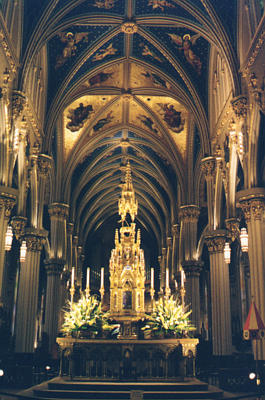
. . . In 1871 the cornerstone for the church of Our Lady of Sacred Heart was laid. Over the next ten years contributions [$5 to $50 donations] from grateful users of Lourdes water would be used to finance the church building. The church would become free of debt in 1888 . . . .
The first discussion of Our Lady of Lourdes appeared in the Ave Maria in January 1870 and was an extract from the London Lamp. The following month, Ave Maria serialized an English translation of Henri Lasserre's Our Lady of Lourdes which Edward Sorin had sent from France . . . .
. . . Our Lady of Lourdes had made her arrival on the Notre Dame campus and Catholics throughout the United States became interested in obtaining the miraculous water.
Cures by Lourdes water, rather than from membership in the Association of Our Lady of Sacred Heart, began to be published.(145)
The longer name first selected for the new Notre Dame church, Our Lady of Sacred Heart, was later shortened to Sacred Heart and is now known as the Basilica of the Sacred Heart.
Mother Angela was also first to divine the significance of a Grotto of Our Lady of Lourdes at St. Mary's: the Academy of St. Mary of the Immaculate Conception. The earlier detailed visitor's letter written in 1877, indicates Mother Angela's plans to build the indoor Grotto at St. Mary's, something she accomplished several years before Father Sorin built his at Notre Dame in 1878.
As early as December of 1874 the St. Mary's section of the Scholastic reports:
The lovely Madeira vine at the Grotto of Lourdes has been shorn of its fragrant blossoms.(146)
Could Sorin have also gotten his idea for the first Grotto at Notre Dame from the one Mother Angela built at St. Mary's? And did Sorin's outdoor Grotto built four years later, in August of 1878, have anything to do with the removal of the one at St. Mary's and the abandonment of Mother Angela's plan to build one in the glen? Again, a desire on Mother Angela's part, perhaps, to please Sorin and not compete with him for a Marian pilgrimage site and the money it was providing to fund the church building still in progress? Could Mother Angela's vow of obedience, been a deciding factor in any outcome concerning Sorin and his wishes?
An excerpt from Sr. Georgia Costin's, Priceless Spirit, may provide an explanation:
Mother Compassion continues into a matter for which Mother Angela has been both praised and blamed.
Mother Angela regarded Very Rev. Father General [Sorin] as God's representative and obeyed him as such, and taught all her Sisters to do the same. No matter how much it cost her or how different her opinion was, as soon as she learned his will she submitted to it without a murmur . . . .
Sorin also had a stubborn persistence of bulldog proportions that tended to become more stubborn when it was opposed. The simple fact is that he did have better judgment, most of the time, than most other people, and it was a judgment backed up by a tremendous faith, the 'priceless spirit of faith' that he endlessly recommended to his religious.(147)
The situation brought to my mind the many references I had seen of Father Sorin's two-sided personality. His beautiful way with words, his obvious devotion to Our Lady, his indefatigable spirit, and also his determination to have his own way. And he was not above enlisting the aid of his often reluctant religious as the following story relates:
Sorin was returning to South Bend on a steamer with several postulants. They were stranded one night on a sandbar and Father Sorin sent the young women among the passengers to collect money for a set of chimes for Notre Dame. He wrote a little speech for them to present to the passengers. The incident was recorded by Sister Rosalie Pepins, one of the postulants on board. "The whole affair," she remarks, "was not only blind, it was also deaf and dumb obedience."(148)
An example of this audacious aspect of Father Sorin's personality, turned up while paging through an 1873 Scholastic:
It seems that Very Rev. Father General in one of his rambles through the studios of Rome came upon a marble statue which an artist was about finishing. It was Mater Admirabilis [Mother Most Admirable]. The subject represents the Blessed Mother in deep meditation, sitting by her spinning-wheel. It has always been V. R. F. Sorin's favorite representation of the Blessed Virgin. Of course he wanted it -- wanted it, right away. There was only one little obstacle to his getting it. The artist regretted to inform him that the statue was intended for the Holy Father. Well, this was rather an obstacle. Many a one would have given up the idea of ever getting the Mater Admirabilis. Not so Father General. He recommended his petition to the artist himself, and on his side prepared for a vigorous attack. But we will let him relate the incident. After speaking of several objects of art which he has purchased in Rome he speaks of this statue in a letter home:
The second is marble, a Mater Admirabilis, which was being made for the Pope: Today at 113/4 a.m. we [Sorin] go to a private audience: if I can prove to the Holy Father that I love very much his chosen model, etc., he may let me carry it away: I am preparing my speech.
July 2 -- Yesterday, at last, I had an audience, more delightful, if possible, than any of the nine audiences I received before. The Holy Father was more of a father to me than I had ever seen him since twenty years. A few moments afterwards, the artist, one of the first sculptors in Rome went to the Vatican with his splendid Mater Admirabilis to present it to his Holiness as a token of his veneration. (I have the following little incident in writing, from the sculptor himself.)
'But, most holy Father,' said the artist, 'here is the card of an American Missionary who came to my studio while I was finishing this your graceful and favorite design; I told him it was for your Holiness. I was giving it the last touch; he looked at it none the less attentively. It appears, most Holy Father, it pleased him so much that he declared he must have it. Those Americans are so positive!'
[Sorin] I answered; if his Holiness permits!
'Ah! -- Padre Sorin! -- certainly, with pleasure. I bless it for him; let him have it.'(149)
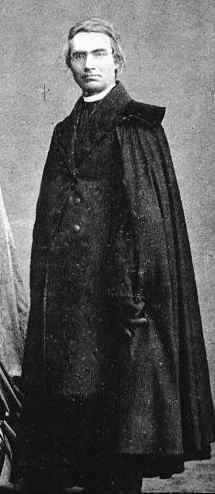 Sorin ends his letter with, "I have the pleasure to announce to you
that it is to be shipped this morning for Notre Dame [August ,
1873]."
Sorin ends his letter with, "I have the pleasure to announce to you
that it is to be shipped this morning for Notre Dame [August ,
1873]."
While it was an amusing incident, it left little doubt of his penchant for realizing his goals. Joseph White recounts another such example of Sorin's philosophy when a close examination revealed a foot-long crack in the old church's largest bell:
Sorin reported that 'a wise head' -- probably Sorin himself -- 'trusting more than the rest in the Blessed Queen of the place suggested that the broken bell be replaced by another, four times, or even five times larger, positively declaring that, while few persons would feel inclined to subscribe anything for an ordinary bell, many would be delighted to contribute for the acquisition of an extraordinary one.'(150)
Think big and always have a dream could have been said by Sorin himself. With his characteristic determination he pursued the effort, raised the funds, and the bell -- which required four men to ring it -- arrived in the summer of 1867. Being too large for the then church, it was placed in a ground level belfry -- which may have been comical at the time -- yet 10 years later it was perfectly suited for the new church where it resides to this day impressing everyone who sees it.
This uncanny ability Sorin had to "come out smelling like a rose" was very like what Rudy Ruettiger attributed to an atmosphere on campus: ". . . a certain force -- an energy . . . allowed each person to perform on a level higher than usual. It came to be called the 'God Loop.' . . . [It] provided good luck when it was least expected."(151) I have experienced that same "good luck when least expected" many times during my Grotto research on campus.
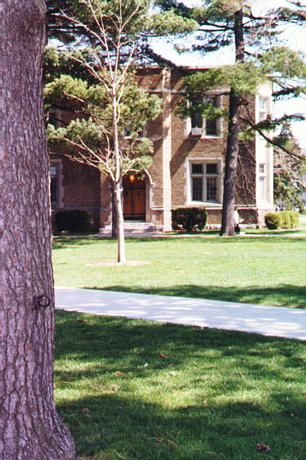
Perhaps in Sorin's case that old adage, "Fortune follows the bold," should be amended to read, Fortune follows the fearless and the faithful. Or as Sorin himself put it, "You can only do good by risking it." And risk it he did, on many occasions. As Father Hope put it, "there were times when Fr. Sorin was just one jump ahead of the sheriff." Yet it does seem that many of his bold actions were the result of pushing his faith to the limits to prove to himself, and others, what unbounded faith can accomplish. What he may have lacked in common sense, he made up for with a terrific imagination. In writing about him I can still feel his boundless energy in the words written by him and about him. They say: "The world steps aside for a man who knows where he's going." Sorin certainly had that quality.
Another example of Fr. Sorin's perseverance was his appointment as Postmaster of a Post Office at Notre Dame. In his Chronicles he wrote: "The regular passage of the mail coach would make the college better known, and causes the public highways leading to it to be carefully maintained" [quoted in Arthur J. Hope, Notre Dame -- 100 Years (Notre Dame: University Press, 1948), p. 74]. It would also bring in more revenue for the college. On January 6, 1851 after a prior attempt failed, Fr. Sorin was made postmaster of a postal station at Notre Dame. His interest in the upkeep of the roads around Notre Dame also prompted him to seek and gain an appointment as Inspector of the Public Ways.
Evidence of the site of the original Notre Dame Post Office still remains today in the hitching rings shown in these photographs. Undoubtedly, Sorin himself used these same hitching rings. They are located in a group of pine trees about 100 feet east of Sorin's statue in front of Hurley Hall.
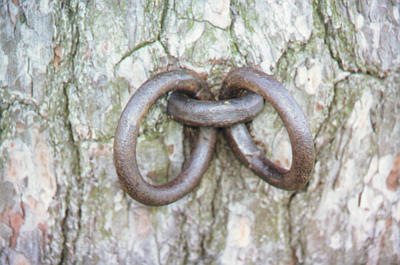
In so many ways, he was also an instrument of Providence for the very reason that he was a man who just wouldn't give up on what he believed to be his mission in life. And because he felt his dream was from and for Our Lady, he was willing to go where no man had gone before in fulfilling his mission. In that respect alone -- the Notre Dame of today has proven -- he was a man of destiny.
And he was not alone in his mission, nor in his determination to fulfill his goals. Mother Angela, on her way to another convent -- whose very presence at Notre Dame, according to Father Hope, was a "religious hijacking" by Sorin -- had her own destiny to fulfill and her own characteristic way of accomplishing it.
I discovered a similar reference to Mother Angela's own strong personality in a collection of letters at the University Archives. The content of the letter surprised me when I read it and seemed to beg to be included as one of those previously undiscovered archival "gems" that might not have been found any other way than in randomly hunting in old letters while looking for something else.
One becomes accustomed to viewing the religious in angelic terms and this unguarded forthright estimation of the human side of Mother Angela's nature surprised me. Because it was not complimentary, I did not plan to include it. However, coming from a general's wife, who was related to her and knew her intimately, one had to take note of it. It made me wonder if some of Sorin's personality had rubbed off on Mother Angela.
The General's wife was writing to her husband about their daughter's forthcoming trip to Europe and Mother Angela's wish to go with her. She speaks of their daughter and her "unwillingness that she not be harassed by her presence":
She would embarrass and annoy her in many way . . . for Mother Angela is unreasonable in her demands upon others and she is moreover totally ignorant of the duties of those not in her own sphere. . . . Please do not intimate that I have written in this way. (152)
As the stories told about Sorin have served to humanize him, it seemed only fair that this 120 year old slice of life from that same year, 1873, be shared to humanize Mother Angela.
Their association was covered very nicely in a book entitled, Priceless Spirit, by Sister M. Georgia Costin, C.S.C. "Sorin saw the great design; Angela supplied the details. He was the architect, she was the contractor."(153) Perhaps it is also only fair to conclude that Notre Dame and St. Mary's might never have existed without two such strong autocratic personalities to found them.
1873 was the same year the General's daughter, Mother Angela, and Father Sorin went separately to Europe and the Grotto Of Lourdes, each with their own traveling companion. It was during this same trip, in August of 1873, that Sorin talked the Pope out of his Mater Admirabilis statue.
The Scholastic reported another Mater Admirabilis statue was also received at St. Mary's a month later, on September 13, 1873. It was sent from Europe by Mother Angela during the same trip. One might think they were one and the same, but Father Sorin's was marble and Mother Angela's a pleasing and colorful painted statue. The fate of Father Sorin's statue is unknown. It may have been destroyed in the 1879 fire in the Main Building. However, the one Mother Angela sent back still graces the South Window of the 4th floor hallway of Bertrand Hall.
I noticed it there some fifteen years ago when the floor it was on was a convent and a Sister friend lived there. I admired it then, though I wondered about the spinning wheel at the time, and who the statue depicted. I didn't know it represented Mary or what it was called. It was a most unusual and appealing statue. Recently, I stopped by Bertrand Hall to see if it was still there or if I had imagined it. I was surprised to find it was in the very same spot at the end of the hallway, although the floor has been drastically changed, remodeled for business offices. It probably has been there ever since it arrived in 1873. I've always wondered about the story behind it and now fifteen years later the answer has finally arrived.
Mary is not forgotten there either. On the corner of the base of the statue were a number of coins, left there I was told, as they do in the third world countries, to be sent to missions. A custom started by a Sister who had been stationed in a third world country, whose office door is adjacent to the statue. She said she had no doubts that it had always been there because when they remodeled the floor they found it too big and too heavy to move elsewhere. Obviously, Mary has her own way of letting her presence be known in quiet out-of-the-way places.
Learning of this aspect of Sorin's personality deepened my speculation on why the St. Mary's Grotto was dismantled. Had she removed their indoor Grotto, once Father Sorin had completed his, to please him, or because he convinced her that two sites for a pilgrimage and the dispensing of Lourdes water were not necessary? It does seem strange that it would have remained in its original condition for only a few years, then be dismantled just months after Sorin dedicated his own on the Notre Dame campus.
Could the building have become uninsurable because of the fire hazard of burning so many candles at an indoor shrine? Were the moss plants on it too difficult to maintain indoors? Or could the reason it was removed be as simple as needing the space for something else? The area allotted to the original 1874 St. Mary's indoor Grotto must have been more than three times the width of the present 6 by 12 foot alcove now narrowed by two closets placed on each side of it. They were questions that would have to go unanswered as there seemed to be no more records left to examine.
However, more information did surface concerning Sorin, Mother Angela and the Lourdes statue that once graced the St. Mary's Grotto and is now in the alcove of Lourdes Hall. As I continued to page through the 1873 Scholastic, I again stumbled upon more references to the fact that Sorin was in Europe at Lourdes at about the same time as Mother Angela. On June 21, 1873 a letter was published in the Scholastic from Sorin which mentioned that he was sending a 6' statue of Our Lady of Lourdes from Paris for the Juniors.(154)
On September 13, 1873, in the St. Mary's section, the Scholastic reports that Father Sorin and Mother Angela arrived from Europe together. It includes this added bit of news:
In a few weeks there will be forwarded to St. Mary's from Paris, a life-size marble [corrected in another entry to 'terre cuite' and plaster cast] statue of Our Lady of Lourdes [the Bernadette statue is mentioned earlier].(155)
Then again, on November 1, 1873, the Scholastic reported in the Notre Dame section:
The statue so long promised to the juniors by Sorin has at last arrived. It is indeed the finest representation we have ever seen. At present it is placed in the large parlor.(156)
It was now apparent. There were two such statues, probably identical. It was also more evidence of Father Sorin's ties to St. Mary's and his interest in Our Lady of Lourdes. This close early association may also explain why Father Maguire thought Sorin had built a Grotto at St. Mary's. Father Sorin and Mother Angela must have been equally impressed with the original Our Lady statue upon visiting Lourdes, France and each sent a replica back for their separate colleges. The fate of Father Sorin's Lourdes statue is unknown. It may also have been a casualty of the Main Building fire, but the one Mother Angela brought back in 1873 (123 years ago) is in Lourdes Hall at St. Mary's to this day, along with the one of Bernadette.
The St. Mary's statues when they arrived were described as "plaster casts of masterpieces of statuary" which may also explain why Mother Angela built an indoor Grotto, because they would not have survived outdoors.
The lifelike painted wooden statue used in Father Jan's Grotto at St. Stanislaus Church had to be replaced with a more durable one. And the current statue of the Blessed Virgin at the present Notre Dame Grotto is painted cement, probably, for the same reason. From past pictures, it appears there were several replacement statues in the Notre Dame Grotto over the years. Except for a few years in the early thirties, the band proclaiming "I Am The Immaculate Conception" was above the statue. It is missing in pictures taken after the late seventies, which gives the statue there now a slightly smaller appearance in proportion to the space allotted for it in the niche.
With this new information surfacing about the twin statues, I began to wonder if the Our Lady of Lourdes statue brought back by Father Sorin for the juniors in 1873 might also have been been used five years later in his own Grotto of Lourdes; the statue placed in its octagonal shaped tower niche and encased in glass, for the same reason. So the statue would not deteriorate in the weather. Could this also have been another possible explanation, for Sorin's shrine-like Grotto?
I was still puzzling over this newest theory when Peter Lysy suggested one day that I might want to check the financial ledgers on Sorin's early 1878 Grotto, as I had done early on in my search with the 1896 Grotto, just in case there were any pieces to the puzzle hidden in the entries recorded. It was a great suggestion, one so obvious, that I'd missed it entirely. One of the pitfalls of researching, I was beginning to learn, was having the answer right under your nose and not being able to recognize it.
Once again, Peter wheeled out two ledgers too heavy for me to lift and a cash book. When he spread them out on their foam cushions, they covered most of a library table. The entries on the Grotto Of Lourdes stood out in beautiful bold calligraphy. I was pleased to find several entries which established the cost of Sorin's shrine-like Grotto which was built in 1878. Its total cost was $562.19, whereas, the Grotto erected by Corby, eighteen years later in 1896, was built for $2500. There were expenses listed for the glass in the tower niche and expenses paid to the masonry account, plus, one other item of particular interest. An entry in the financial expense record amounting to $47.52, with $6.62 shipping charges paid to J. A. McSorley, for a statue to be used in Sorin's original Grotto of Our Lady of Lourdes.(157)
Shortly afterward, a bill from McSorley for a Lourdes statue, dated January 7, 1878, surfaced. The statue was described as being -- meters (6 feet) costing 500 francs ($107 written below it). A comparison of the amounts of the two invoices indicates that it is possible the first bill for the lesser amount might have been the statue of Bernadette.(158) In addition to supplying religious articles, McSorley also solved an earlier difficulty in obtaining Lourdes water and began importing it from France for Notre Dame in 1877.
Since the statue used in Sorin's 1878 Grotto was purchased in 1878, it could not have been the twin to Mother Angela's authentic Lourdes statue as I first supposed. One more theory ruled out.
I could finally close the book on another item mentioned in Father Maguire's letter of correction concerning the Notre Dame Grotto. Sorin did build a Grotto, but not at St. Mary's. That was Mother Angela's own idea. He built it at Notre Dame 18 years before the present one was erected. The location of Father Sorin's authentic Lourdes Statue, the twin of Mother Angela's, his marble Mater Admirabilis, and his reason for building a shrine-like Grotto -- so unlike the present one -- would have to remain an unsolved mystery along with the reason Mother Angela dismantled hers.
I concluded my latest search by documenting the St. Mary's Lourdes Hall statues in the present alcove with photographs, anticipating a brief respite from my archival detecting during the Christmas holidays.